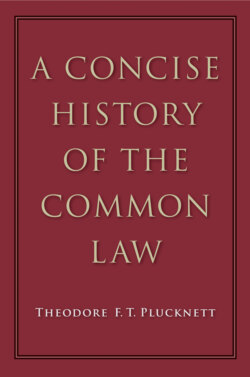Читать книгу A Concise History of the Common Law - Theodore F. T. Plucknett - Страница 134
На сайте Литреса книга снята с продажи.
THE COURT OF KING’S BENCH
ОглавлениеThe five justices who at first constituted the new court were expressly subordinated to the magnates and wiser men to whom difficult cases were to be referred. For some years the highest law court consisted, therefore, of these greater and wiser men who were in constant attendance upon the King. It is a frequent recurrence in all this judicial and constitutional history that the group of advisers in the immediate presence of the King should exercise in his name a wide discretion, and that these powers should in no way be diminished by the successive developments of the Exchequer and the Court of Common Pleas. Just as the Exchequer had formed round the financial routine, and the Court of Common Pleas was to grow up with the common law forms of action, so the constant occupation of the King’s immediate advisers with matters referred to them from the Common Pleas, and also with matters particularly touching the King, gave rise to a new body of procedure, and soon to a new court—the Court of King’s Bench, or, in its full mediaeval title, “The Justices assigned for the holding of Pleas before the King himself”.1 Normally, such pleas would have been heard literally “before the King himself”, but that was impossible with an absentee King such as Richard I. The court coram rege appears under John, but vanishes when he goes to the continent. The minority of Henry III again made it impossible to speak of pleas coram rege, but by this time the need for such a jurisdiction was so great that it was determined by way of compromise to hold some pleas coram consilio, the rest being deferred until the King should come of age. Hence in its early days it is often impossible to distinguish these judicial proceedings before the King (Coram Rege) from proceedings before the Council, and the early rolls of the court sometimes contain miscellaneous acts of the Council. The procedures around which it finally developed were the correction of error in the Common Pleas, and the trial of those pleas of the Crown which were of exceptional concern to the King.2
There are rolls still in existence, bearing the proceedings of both branches of the Curia Regis, beginning in the year 1194; a separate series of common plea rolls (technically called de banco rolls) begins in the year 1234, and in 1237 a defendant in a plea coram rege is found objecting that the case ought to have been brought in the common pleas.3
